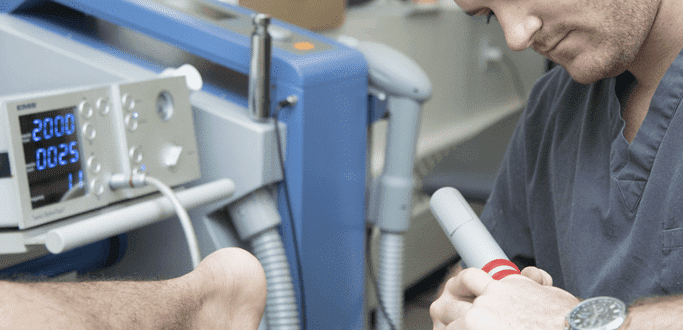In people who are especially active, tendons can take a beating. Although they are elastic and sturdy, hard work, heavy exercise and even the aging process can lead to inflammation.
This condition, called tendonitis, is usually remedied by simply applying ice and giving the tendon a good rest. Shoe inserts or splints are sometimes recommended.
When patients have tried conventional treatments but continue to experience pain, Extracorporeal Shock Wave Therapy is an option. ESWT is a noninvasive procedure that delivers mechanical, low-energy sound waves through the skin. The shock waves accelerate healing by increasing blood flow to the area of the injury.
Tendons in all areas of the body are subject to inflammation. The most common injuries are listed below:
- Partially torn or ruptured Achilles tendon
- The Achilles tendon, stretching from the calf muscle to the heel bone, is the most susceptible to injury. Signs of damage include swelling, pain, stiffness or tenderness in the heel area.
- If the tendon is ruptured, it’s not uncommon to feel a sudden pop. Ruptured Achilles tendons are extremely painful and make walking impossible.
- Runners, basketball players, gymnasts and ballet dancers are at high risk for injury. Wearing ill-fitting or poorly designed shoes can also invite a world of trouble. Stretching before a workout and adding new challenges gradually are good preventative measures.
That’s a fancy name for tennis elbow. People who repeatedly bear weight and make forceful motions with their wrists and hands – such as tennis players, grocery checkers and construction workers – are at risk of developing lateral epicondylitis.
Discomfort begins in the elbow area and spreads to the forearm. A serious case of tennis elbow causes searing pain that is made worse by lifting or gripping anything at all.
This condition, also called heel spurs, starts with mild pain on the bottom of the foot. It’s usually most noticeable first thing in the morning or immediately following a workout. Putting weight on the foot is severely uncomfortable.
Plantar fasciitis is a common problem for people who are on their feet a lot. Restaurant workers frequently develop heel spurs, especially if their feet are flat or very highly arched. Running or walking long distances and being overweight are other causes.
Patellar inflammation affects the tendon connecting the thigh muscles to the shin bone. Pain occurs suddenly just below the kneecap.
In addition to track athletes who participate in jumping events, dancers, volleyball players, basketball players and cyclists are susceptible.
The supraspinatus is in a group of tendons and muscles, called the rotator cuff, that connects the shoulder blade to the upper arm. Inflammation causes soreness and weakness during movement.
People who make forceful overhead arm movements, like house painters, baseball players and competitive swimmers, often damage tendons in the rotator cuff.
There’s no reason to suffer long-term pain with a tendon injury. ESWT is the new wave in viable treatment options.


























































